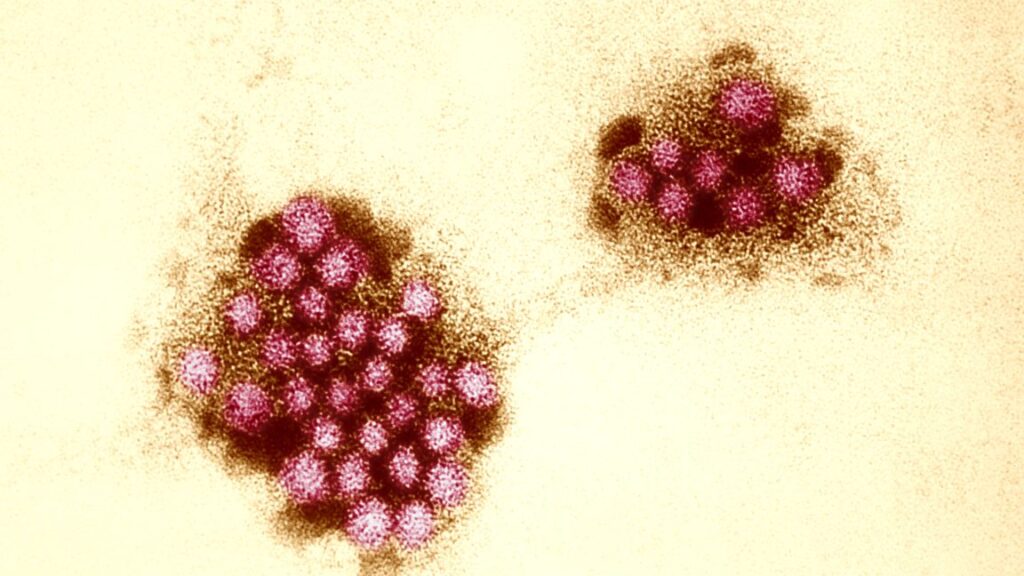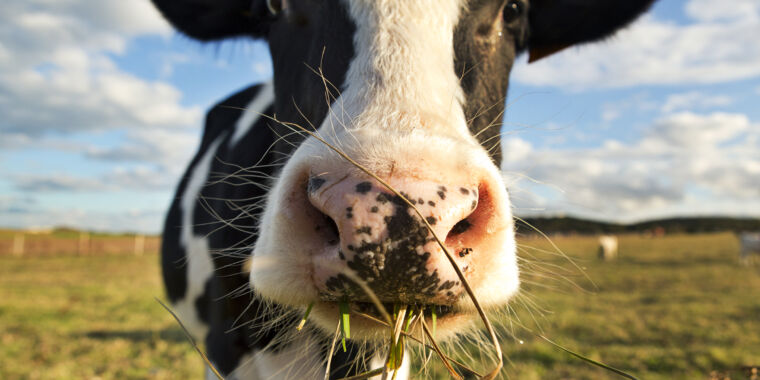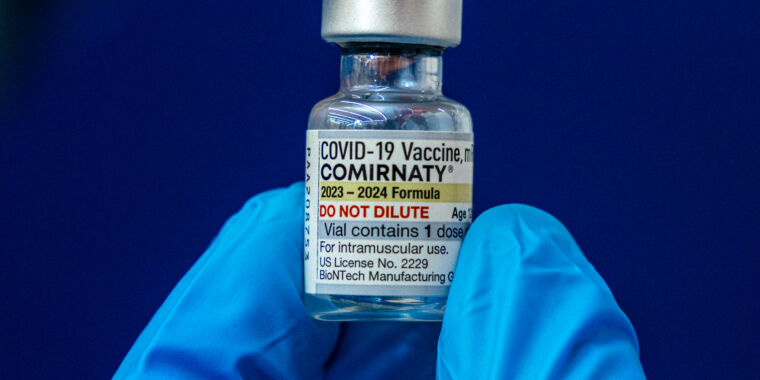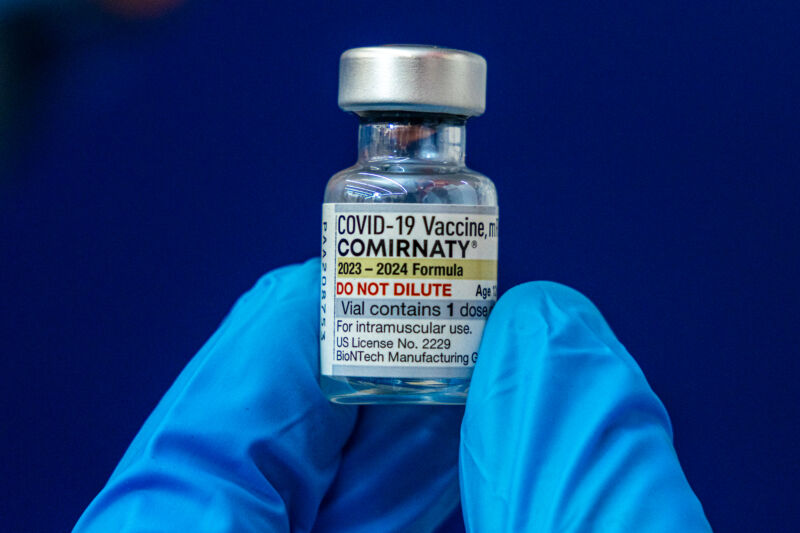Norovirus vaccine hints at defusing explosive stomach bug in early trial
Phase I study showed vaccine was safe and spurred immune responses in older people.
An electron micrograph of norovirus. Credit: Getty| BSIP
In an early clinical trial, an experimental norovirus vaccine given as a pill produced defensive responses exactly where it counts—in the saliva of older people most vulnerable to the explosive stomach bug.
The results, published this week in Science Translational Medicine, are another step in the long effort to thwart the gruesome germ, which finds a way to violently hollow out innards wherever people go—from restaurants to natural wonders and even the high seas. It’s a robust, extremely infectious virus that spreads via the nauseating fecal-oral route. Infected people spew billions of virus particles in their vomit and diarrhea, and shedding can last weeks. The particles aren’t easily killed by hand sanitizers and can linger on surfaces for up to two weeks. Exposure to as few as 10 virus particles can spark an infection. According to the Centers for Disease Control and Prevention, norovirus causes an average of between 19 and 21 million cases of acute gastroenteritis in the US every year, leading to 109,000 hospitalizations and 900 deaths. This racks up an economic burden estimated to be $2 billion to $10.6 billion.
Vaccine design
For most, the gut-busting bug is miserable but usually over in a few days. But older people—especially those with underlying medical conditions—are vulnerable to severe outcomes. About 90 percent of people who die from a norovirus infection are people age 65 or older who live in long-term care facilities.
For this reason, researchers have aimed to design a vaccine that’s sure to be effective in older people, who typically have weaker immune responses just from the aging process. But, of course, this makes the already daunting task of developing a vaccine yet harder—and norovirus poses some specific challenges. For one, there aren’t a lot of good laboratory models and animal systems to run norovirus experiments or test candidate drugs. For example, healthy mice infected with a mouse version of norovirus don’t develop any symptoms (lucky critters). Then there’s the fact that norovirus isn’t one virus; it’s many. There are 49 different genotypes of norovirus, which have been categorized into 10 “genogroups.” It’s unclear if protection against one genotype or genogroup will help protect against the others, and if so, by how much.
Currently, there are several norovirus vaccines in the works, at various stages with various designs. The one published this week is being developed by a San Francisco-based company called Vaxart and uses a proprietary oral delivery system. The pill includes a deactivated virus particle (an adenovirus), which can’t replicate in people but can deliver the genetic blueprints of two molecules into cells lining our intestines. One of the genetic blueprints it delivers tells the intestinal cells how to manufacture a protein found on the outside of norovirus particles, called VP.1. Once manufactured in the intestines, VP.1 can train the immune system to identify invading norovirus particles and attack them. The other genetic code included in the vaccine is for what’s called an “adjuvant,” which is basically a booster molecule that helps rev up immune responses.
While several other vaccines in the works are delivered by injections, producing systemic responses, the idea of the pill is to build up immune responses to norovirus directly where it invades and attacks—the mucosal lining of the digestive tract, including the mouth and intestines. There is some preliminary data suggesting that having antibodies against norovirus in saliva correlates with protection from the virus.
Good news
Vaxart has previously published Phase I trial data showing that its pill is safe and well-tolerated in healthy adults ages 18 to 49. The study, published in 2018, also indicated that the pill generated “substantial” systemic and mucosal antibodies against norovirus.
For the new study, Vaxart did a repeat Phase I trial with 65 older people—ages 55 to 80, broken into groups of 55 to 65, and 66 to 80. The participants were randomly assigned to get either a placebo (22) or a low (16), medium (16), or high (11) dose of the vaccine VXA-G1.1-NN, which targets one genotype of norovirus. Again, the vaccine was safe and well-tolerated. There were no serious side effects. The most common side effects were headache and fatigue, which were reported at about the same rates among the placebo and vaccinated groups.
Further, detailed examination of the participants’ immune responses showed not only systemic response, but responses in distant mucus membranes. In the blood, two types of antibodies (IgA and IgG) increased by several fold after vaccination compared with the placebo group. The group with the largest responses was the one that received the high dose.
A test that acts as a surrogate for neutralizing antibody responses to norovirus indicated that the antibodies spurred by the vaccine could block the virus. Additional tests found that cellular immune responses were also activated and that the systemic responses result in protection in places far from the intestines—namely the mouth and nose. Saliva tests and nasal swabs found significant jumps in secreted IgA against norovirus.
Immune responses were strongest in the first two months after vaccination and diminished over time, but some persisted for nearly seven months. When the scientists looked at differences between the two age groups (55–65 and 65–80), they didn’t see significant differences, suggesting the vaccine was equally effective in the older group.
Overall, the scientists at Vaxart concluded that the vaccine “has the potential to inhibit infection, viral shedding, and transmission.”
“Overall, VXA-G1.1-NN administration in older adults led to robust and durable immunogenicity detected both in circulation and multiple mucosal sites, an exciting outcome considering that diminished cellular and mucosal immunity are typical in older populations,” they wrote.
Not so good news
The outlook isn’t entirely rosy, though—there is some bad news. While immune responses rose in statistically significant measures during this small early-stage trial, it’s unclear if that equates to real-life protection. And there’s some good reason to be wary. In 2023, Vaxart released results of a challenge study, in which 141 brave souls (76 vaccinated and 65 given a placebo) were deliberately exposed to norovirus to see if the vaccine was protective. The results were weak: 53 placebo-group members (81.5 percent) became infected with norovirus, as determined by a PCR test looking for genetic evidence of the virus in their stool—and so did 76 vaccinated people (60 percent). That worked out to the vaccine offering only a 29 percent lower relative risk of getting infected. Looking at whether infected people developed symptoms of acute gastroenteritis, the vaccine had a protective efficacy of about 21 percent: 34 vaccinated people (48 percent) versus 37 placebo-group members (57 percent) developed symptoms.
While the study was a disappointment, Vaxart wasn’t ready to give up, arguing that the challenge study used large-dose exposures that people wouldn’t encounter in the real world.
“We use lots of copies of virus to ensure a high infection rate. In nature, 10 to 15 copies of virus is generally enough to give certain susceptible individuals disease,” James Cummings, chief medical officer at Vaxart, said in an investor call reported by Fierce Biotech at the time. “Field efficacy generally goes up, because the amount of inoculum that is causing disease that will be seen in the field is far lower than what is seen in the challenge study. My projection is that we would see an improvement in the decrease of [acute gastroenteritis] with our vaccine.”
Even a slight boost in efficacy could make the vaccine seem worthwhile. A 2012 modeling study suggested that even a vaccine with 50 percent efficacy could avert up to 2.2 million cases and save up to $2 billion over four years.
For now, we’ll have to wait to see what future trial data shows. And Vaxart’s vaccine isn’t the only one in the pipeline, nor is it the furthest along. Moderna has a norovirus vaccine in a Phase 3 trial, which is a larger study that will look at efficacy. But, while the trial is just beginning, Moderna noted in a financial update in February that the trial has been put on hold by the Food and Drug Administration due to a possible neurological side effect in one participant.
“The trial is currently on FDA clinical hold following a single adverse event report of a case of Guillain-Barré syndrome, which is currently under investigation,” Moderna reported. “The Company does not expect an impact on the study’s efficacy readout timeline as enrollment in the Northern Hemisphere has already been completed. The timing of the Phase 3 readout will be dependent on case accruals.”
Beth is Ars Technica’s Senior Health Reporter. Beth has a Ph.D. in microbiology from the University of North Carolina at Chapel Hill and attended the Science Communication program at the University of California, Santa Cruz. She specializes in covering infectious diseases, public health, and microbes.
Norovirus vaccine hints at defusing explosive stomach bug in early trial Read More »





